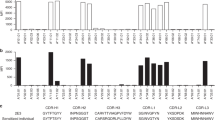Abstract
The human receptor for the C3b/C4b fragments of complement, designated CR1, is a large glycoprotein comprised of a single polypeptide chain that exhibits genetically regulated structural and quantitative polymorphisms. The structural polymorphisms are manifested in an autosomal codominant expression of different allotypic proteins; all allotypic forms are capable of binding C3b1,2,3,4. The most common proteins have MW of 250,000 (F allotype) and 260,000 (S allotype) by NaDodSO/PAGE, although rarer forms differ by as much as 90,000 daltons4. Removal of the N-linked oligosaccharides does not eliminate this polymorphism, suggesting that the primary structures of the various allotypic forms are different1. CR1 is an integral membrane glycoprotein residing on erythrocytes, polymorphonuclear leukocytes, monocytes/macrophages,fiall B and some T lymphocytes, and renal glomerular epithelial cells5,6. Quantitative polymorphism refers to the number of receptor sites on erythrocytes, which varies by 10-fold among different individuals. Population and family studies have shown that there are two autosomal codominant alleles that determine the quantitative polymorphism.
Access this chapter
Tax calculation will be finalised at checkout
Purchases are for personal use only
Preview
Unable to display preview. Download preview PDF.
Similar content being viewed by others
References
W.W. Wong, J.G. Wilson, and D.T. Fearon, Genetic regulation of a structural polymorphism of human C3b receptor, J. Clin. Invest. 72: 685 (1983).
T.R. Dykman, J.L. Cole, K. Iida, and J.P. Atkinson, Polymorphisms of human erythrocyte C3b/C4b receptor, Proc. Natl. Acad. Sci. USA 80: 1698 (1983).
T.R. Dykman, J. Hatch, and J.P. Atkinson, Polymorphisms of the human C3b/C4b receptor, J. Exp. Med., 159: 691 (1984).
T.R. Dykman, J. A. Hatch, M.S., and J.P. Atkinson, Polymorphism of the C3b/C4b receptor (CR1): characterization of a fourth allele, J. Immunol. 134: 1787 (1985).
D.T. Fearon and W.W. Wong, Ligand-receptor interactions that mediate biological responses, Ann. Rev. Immunol. 1: 243 (1983).
S.H. Yoon and D.T. Fearon, Characterization of a soluble form of the C3b/C4b receptor (CR1) in human plasma, J Immunol. 134: 3332 (1985).
W.W. Wong, R.M. Jack, J.A. Smith, C.A. Kennedy, and D.T. Fearon, Rapid purification of the human C3b/C4b receptor (CR1) by monoclonal antibody affinity chromatography, J. Immunol. Methods 22: in press (1985).
W.W. Wong, L.B. Klickstein, J.A. Smith, J.H. Weis, and D.T. Fearon, Identification of a partial cDNA clone for the human receptor for complement fragments C3b/C4b, Proc. Natl. Acad. Sci. USA 82: in press 1985.
F. Sanger and A.R. Coulson, A rapid method for determining sequences in DNA by primed synthesis with DNA polymerase, J. Mol. Biol. 94: 441 (1975).
H. Lehrach, D. Diamond, J.M. Wozney, and H. Boedtker, RNA molecular weight determinations by gel electrophoresis under denaturing conditions, a critical reexamination, Biochemistry 16: 4743 (1977).
P.S. Thomas, hybridization of denatured RNA and small DNA fragments transferred to nitrocellulose, Proc. Natl. Acad. Sci. USA 77: 5201 (1980).
E. Southern, Detection of specific sequences among DNA fragments separated by gel electrophoresis, J. Mol. Biol. 98: 503 (1975).
H.P.J. Bennett, A.M. Hudson, C. McMartin, and G.E. Purdon, Use of octadecasilyl-silica from the extraction and purification of peptides in biological samples, Biochem. J. 168: 9 (1977).
Author information
Authors and Affiliations
Editor information
Editors and Affiliations
Rights and permissions
Copyright information
© 1987 Plenum Press, New York
About this chapter
Cite this chapter
Staith, J.A., Wong, W.W., Klickstein, L.B., Weis, J., Fearon, D.T. (1987). Human C3b/C4b Receptor (Cr1): Isolation, Protein Sequence Analysis, and Cloning of a Partial cDNA from Human Tonsil. In: L’Italien, J.J. (eds) Proteins. Springer, Boston, MA. https://doi.org/10.1007/978-1-4613-1787-6_74
Download citation
DOI: https://doi.org/10.1007/978-1-4613-1787-6_74
Publisher Name: Springer, Boston, MA
Print ISBN: 978-1-4612-9001-8
Online ISBN: 978-1-4613-1787-6
eBook Packages: Springer Book Archive



